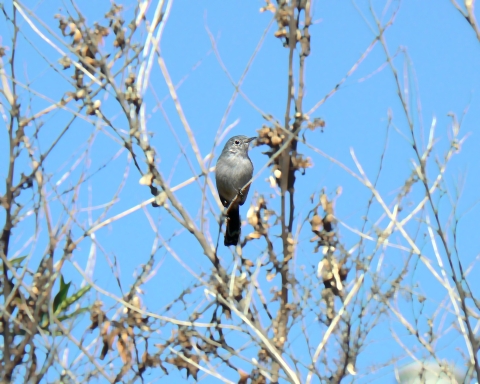Length: 4.3 in (11 cm) |
Wingspan: 5.5 in (14 cm) |
Weight: 0.2-0.3 oz (5-7 g) |
Listing Status
The coastal California gnatcatcher is listed as federally threatened and is also designated as a Bird Species of Special Concern by the State of California.
Range
The gnatcatcher is found on the coastal slopes of southern California, from southern Ventura southward through Los Angeles, Orange, Riverside, San Bernardino, and San Diego counties into Baja California, Mexico, to approximately 30 degrees North latitude near El Rosario. Within its range, the distribution of coastal California gnatcatcher is further defined by relatively narrow elevation limits. In general, inland populations of the gnatcatcher can be found below the 1,640-foot (500-meter) elevation, and coastal populations tend to be found below an elevation of 820 feet (250 meters).
Habitat
This gnatcatcher typically occurs in or near coastal sage scrub, a habitat characterized by relatively low growing, dry-season deciduous, and succulent plants. Characteristic plants of these communities include California sagebrush sagebrush
The western United States’ sagebrush country encompasses over 175 million acres of public and private lands. The sagebrush landscape provides many benefits to our rural economies and communities, and it serves as crucial habitat for a diversity of wildlife, including the iconic greater sage-grouse and over 350 other species.
Learn more about sagebrush , California buckwheat, laurel sumac, lemonade berry, bush penstemon, and various species of sage (Salvia spp.).
Migration
Gnatcatchers are non-migratory and exhibit strong site tenacity. Pairs strongly defend territories during the breeding season against other gnatcatchers and predators, and some will defend territories throughout the year. During the non-breeding season, gnatcatchers have been observed to wander in adjacent territories and unoccupied habitat increasing their home range size to approximately 78 percent larger than their breeding territory.
Breeding Season
The gnatcatcher breeding season extends from late February through early August, with the peak of nesting attempts occurring from mid-March through mid-May. Nests are constructed over a 4- to 10-day period and are most often placed in perennial species of coastal sage scrub about three feet (1.2 meters) above the ground. Within the Otay-Sweetwater Unit, gnatcatcher populations occur in high-quality coastal sage scrub and persist in high densities.
Refuge Occurrence
Prior to the Harris Fire in 2007, the Refuge supported approximately 6,175 acres (2,500 hectares) of high-quality coastal sage scrub. After the fire, the Refuge supported about 3,610 acres (1,460 hectares) of this high-quality habitat located in areas such as the lower slopes of McGinty Mountain, the north side of the Las Montañas area, the ridge and associated slopes along the south side of the Par Four area, and the slopes to the west of the Sweetwater River south of Highway 94. Today, the Refuge includes additional areas of recovering habitat to support this species.




